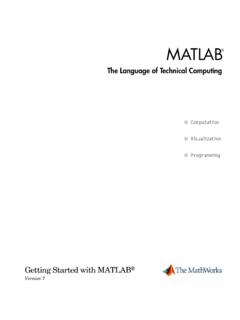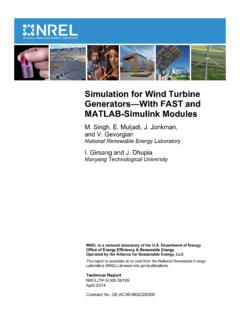Transcription of 2.6.2 Process for calculating Attainment of COs , POs and …
1 Process for calculating Attainment of COs , POs and PSOs INDEX. Sr. No Particular Page No 1 Mapping of Course outcomes of subject DSP Processor &Architecture 2. with program outcomes 2 Mapping of Course outcomes of subject DSP Processor &Architecture 3. with program specific outcomes 3 Program level Course- PO matrix 4-5. 4 Method of Measuring Attainment of CO: 6-8. i) Assessment Tools used ii) Course Attainment Level 5 Average Attainment levels of COs of all subject for Session 2015-16 9. 6 Attainment of POs and PSOs 10-11. i) Method of Measuring Attainment of PO and PSO. ii) Direct and indirect assessment tools 7 PO Attainment for Session 2015-16 12-46. 8 PSO Attainment for Session 2015-16 47-52. 9 Average Attainment Table of POS & PSOS 53-59. 1. Department of Electronics Engineering 1) Mapping of Course outcomes with program outcomes PROGRAM OUTCOMES (POs). Engineering Graduates will be able to: 1. Engineering Knowledge: Apply the knowledge of mathematics, science, Engineering fundamentals, and an Engineering specialization to the solution of complex Engineering problems.
2 2. Problem Analysis : Identify, formulate, review research literature, and analyze complex Engineering problems reaching substantiated conclusions using first principles of mathematics natural sciences, and Engineering sciences. 3. Design/Development of Solutions : Design solutions for complex Engineering problems and design system components or processes that meet the specified needs with appropriate consideration for the public health and safety, and the cultural, societal, and Environmental considerations. 4. Conduct Investigations of Complex Problems : Use research-based knowledge and research methods including design of experiments, analysis and interpretation of data, and synthesis of the information to provide valid conclusions. 5. Modern Tool Usage : Create, select, and apply appropriate techniques, resources, and modern Engineering and IT tools including prediction and modeling to complex Engineering activities with an understanding of the limitations.
3 6. The Engineer and Society : Apply reasoning informed by the contextual knowledge to assess societal, health, safety, legal and cultural issues and the consequent responsibilities relevant to the professional engineering practice. 7. Environment and Sustainability: Understand the impact of the professional Engineering solutions in societal and Environmental contexts, and demonstrate the knowledge of, and need for sustainable development. 8. Ethics: Apply ethical principles and commit to professional ethics and responsibilities and norms of the Engineering practice. 9. Individual and Team Work: Function effectively as an individual, and as a member or leader in diverse teams, and in multidisciplinary settings. 10. Communication: Communicate effectively on complex Engineering activities with the Engineering community and with society at large, such as, being able to comprehend and write effective reports and design documentation, make effective presentations, and give and receive clear instructions.
4 11. Project Management and Finance: Demonstrate knowledge and understanding of the Engineering and management principles and apply these to one's own work, as a member and leader in a team, to manage projects and in multidisciplinary Environments. 12. Life - Long Learning : Recognize the need for, and have the preparation and ability to engage in independent and life-long learning in the broadest context of technological change. 2. Sample subject : DSP Processor &Architecture Subject Course Outcomes Program Outcomes 1 2 3 4 5 6 7 8 9 10 11 12. DSP 1. To understand the fundamental of basic 2 2 3 3 2 3 2 2 3. Processor Programmable DSPs and data types. &Architecture 2. To describe the detailed architecture, bus 2 2 3 3 2 3 2 2 3. structure and addressing modes of TMS320C5X. DSP processor. 3. To understand and make use of Assembly 2 2 3 3 2 3 2 2 3. Language Instructions to design simple ALP and describe operations of DSP starter kit.
5 4. To describe the detailed architecture and 2 3 2 2 2 2 2 2 3. addressing modes of TMS320C54X DSP processor. 5. To compare the various advanced Programmable 2 3 2 2 2 2 2 2 3. DSPs and understand the Code Composer Studio. 6. To design multi-rate filters and evaluate 2 2 2 3 3 1 2 2 3. performance of DFT and FFT for filtering data sequences. Average 2 3 2 3 2 2 2 2 3. 2) Mapping of Course outcomes with program specific outcomes of Electronics Dept Program Specific Outcomes (PSOs). Engineering Graduates will be able to: 1. To identify, formulate and analyze the problems in Electronics Engineering by using principles of Mathematics and Engineering fundamentals. 2. Applying Electronics Engineering knowledge to design a system, analyze and interpret data to obtain valid conclusions. 3. Use of various simulation tools such as Tanner Tool, matlab , MULTISIM, ORCAD etc for design and analysis of various systems. 3. Subject Course Outcomes Program specific outcomes 1 2 3.
6 DSP Processor 1. To understand the fundamental of basic Programmable DSPs 2 2 2. &Architecture and data types. 2. To describe the detailed architecture, bus structure and 3 1 2. addressing modes of TMS320C5X DSP processor. 3. To understand and make use of Assembly Language 2 3 3. Instructions to design simple ALP and describe operations of DSP starter kit. 4. To describe the detailed architecture and addressing modes of 2 3 2. TMS320C54X DSP processor. 5. To compare the various advanced Programmable DSPs and 3 3 3. understand the Code Composer Studio. 6. To design multi-rate filters and evaluate performance of DFT 2 2 2. and FFT for filtering data sequences. Average 2 3 2. 4. 3) Program level Course- PO matrix P. P P P P O. Sem/Course Name PO PO P O O O PO O 1 PO. 1 2 O3 4 5 6 7 PO8 PO 9 10 1 12. Sem-I &II. Applied Mathematics-I 3 3 2 3 1 1 1. Engineering Physics 3 3 3 3 1 3 2 2 1 3 3. Engineering Chemistry 2 1 2 1 1 2 2 1 2 2.
7 Basic Electrical Engineering 2 3 2 3 1 2 1 1 1 3. Basics of Civil Engineering 2 3 3 1 1 3 3 2 1 1 1 2. Engineering Graphics -1 . 3 3 3 3 3 2 2 2 3 3 3 2. Communication Skill 2 1 1 2 2 2 2 3 1 3. Applied Mathematics -II 3 3 1 2 2 1 1 1 1. Advanced Physics 3 3 3 3 1 3 2 2 1 3 3. Materials Chemistry 2 1 2 2 2 2 2 2. Engineering Mechanics 3 3 1 3 1 2 1 1 2 1 2 3. Advanced Electrical Engineering 2 2 3 2 1 2 1 1 1 2. Engineering Graphics -II. 3 3 3 3 3 2 2 2 3 3 3 2. SEM III. -Applied Mathematics III 3 2 3 2 1 1 3 1. Electronic Devices And 3 3 3 2 2 2 2. Circuits Electronic Measurements &. Instrumentation 2 2 3 3 2 2 3 3 2 2. Network analysis and 3 3. synthesis Object oriented 3 3 2 2 3 3 2 3. programming & Data Structure SEM IV. Applied Mathematics IV 3 3 2 1 1. Digital Circuits &. Fundamental of Microprocessors 3 3 2 3 3 2 1 1 1 1. Signals & Systems 3 2 2 3 2 2 1 3 2 3. 5. P. P P P P O. Sem/Course Name PO PO P O O O PO O 1 PO. 1 2 O3 4 5 6 7 PO8 PO 9 10 1 12.
8 3 3 2 3 3 2 2 2 2 2. Electromagnetic Fields Power Devices and 3 3 3 2 1 1 2 2. Machines SEM V. Switching Theory &. 3 2 2 3 2 2 1 1. Antenna Analog Circuits & Design 3 3 2 2 2 3 1 3 2 1 2. Engg Economics & Ed 3 2 2 3 2 3 3 2 2. Communication Electronics 3 3 2 2 3 1 1 2 1 1. Microprocessor & 3 2 2 3 1 2 2. Microcontroller SEM VI. Microwave Engineering 2 1 2 1 1 1 1 2 1 2 2 2. Control System Engineering 3 3 1 3 1 1 1 2 2. 3 3 3 3 1 1 2 1 1 2 3 3. Digital Signal processing Functional English 2 3 2 3 2. Digital Communication 3 2 2 2 2 3 2 1 2 1 1 2. SEM VII. 2 3 2 3 2 2 2 2 3. DSPA & Arch Optical Communication 3 3 2 3 3 2 2 1 1 1 1. Embedded System 2 3 3 2 3 3 2 1 1 2 1. 3 3 2 3 3 2 3 2 2 2 3 2. ADSD. Mobile Communication 3 3 2 1 1 2 2 1 1 2 2 3. DIP 3 3 3 3 3 2 1. SEM VIII. Computer Communication 3 2 3 2 2 3 2 2 2 2 1 2. Network MEMS 3 2 3 3 2 1 1 1 1 1. CMOS 3 3 2 3 3 2 1 1 1 1. 3 2 3 3 3 3 2 3 3 3 2 3. WSN. DCE 3 3 2 2 2 3 1 1 3.
9 6. 4) Method of Measuring Attainment of CO: CO Attainment is measured in terms of actual percentage of students getting set (target) percentage of marks. If targets are achieved then all the course outcomes are attained for that year. If targets are not achieved, the Programme put in place an action plan to attain the target in subsequent years. The Attainment levels are set considering average performance levels in all examinations throughout the semester or year. Attainment level is measured in terms of student performance in internal assessments with respect to the COs of a course and the performance in the University examination. Attainment levels are stated in terms of percentage of students getting more than the targeted average marks. Assessment Tools, Process , and levels for CO Attainment used are given in following tables. iii) Assessment Tools used: Home Assignment-Each and every student is assigned with course related tasks during every course work.
10 Twice and assessment will be done based on their performance. Grades are assigned depending on their innovation in solving the problems. Class Assessment Test-This type of performance assessment is carried out during the examination sessions which are held twice a semester. Each test is focused in attaining the course outcomes. Semester End Examination-Semester End examination is a metric for assessing whether all the COs are attained or not. Examination is more focused on Attainment of course outcomes and program outcomes using a descriptive exam. Project Evaluation- Project review seminars are conducted twice in a semester and are evaluated by internal and external evaluators. Laboratory Assessment- Each experiment is assessed by the subject teacher on different parameters like performance of experiment and oral questions. Grades are assigned to each experiment based on continuous assessment. Student portfolios- Department has a student forum, various portfolios are assigned to the students like president, vice president, secretary, treasurer, various committees are also formed like technical committee, discipline committee etc.






